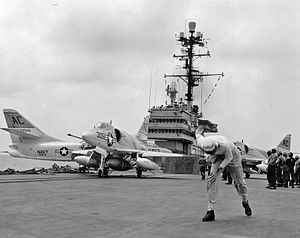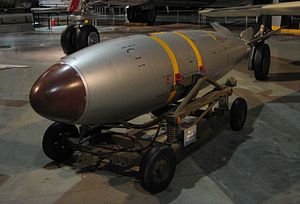- Mark 7 nuclear bomb
-
Mark 7 "Thor" (or Mk-7'[1]) was the first tactical nuclear bomb adopted by US armed forces. It was also the first weapon to be delivered using the toss method with the help of the low-altitude bombing system (LABS). The weapon was tested in Operation Buster-Jangle. To facilitate external carry by fighter bomber aircraft, Mark 7 was fitted with retractable stabilizer fins. Mark 7 was a dial-a-yield capsule-type weapon with fissionable elements (uranium 235) stored in a separate container. The Mark 7 warhead (W7) also formed the basis of the 30.5 inch (77.5 cm) BOAR rocket, the Mark 90 Betty nuclear depth charge, and MGR-1 Honest John rocket and MGM-5 Corporal ballistic missile. It was also supplied for delivery by Royal Air Force Canberra aircraft assigned to NATO in Germany under the command of SACEUR. This was done under the auspices of Project E - an agreement between the USA and the UK on the RAF carriage of US nuclear weapons. The Mark 7 was in service from 1952 to 1968 with 1700-1800 having been built.
Contents
Survivors
A Mark 7 casing is on display in the Cold War hangar at the National Museum of the United States Air Force in Dayton, Ohio.
Specifications
- Length: 15.2 ft (4.6 m)
- Diameter: 2.5 ft (0.8 m)
- Weight: 1680 lb (764 kg)
- Fuzing: airburst or contact
- Yield: variable yield between 8 and 61 kilotons
Users
 A Douglas A4D-2 carrying a Mk 7 bomb on the USS Saratoga in the early 1960s.
A Douglas A4D-2 carrying a Mk 7 bomb on the USS Saratoga in the early 1960s.
- English Electric Canberra (Royal Air Force)
- Douglas F3D-2B Skyknight
- Douglas A-1 Skyraider
- Douglas A-3 Skywarrior
- Douglas A-4 Skyhawk
- Martin B-57 Canberra
- McDonnell F2H Banshee
- McDonnell F3H Demon
- McDonnell F-101 Voodoo
- North American FJ Fury
- North American B-45 Tornado
- North American F-100 Super Sabre
- Republic F-84 Thunderjet
References
See also
External links
Lists relating to aviation General Aircraft (manufacturers) · Aircraft engines (manufacturers) · Airlines (defunct) · Airports · Civil authorities · Museums · Registration prefixes · Rotorcraft (manufacturers) · TimelineMilitary Accidents/incidents Records Categories:- Cold War nuclear bombs of the United States
Wikimedia Foundation. 2010.

